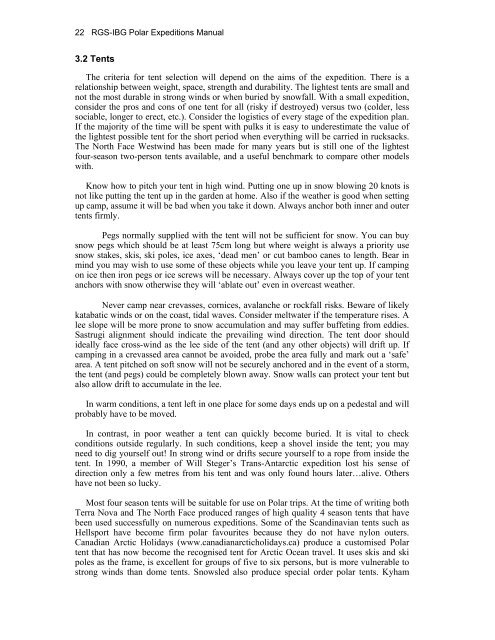Edited by Rachel Duncan 4th Edition ISBN 0-907649-91-2 London ...
Edited by Rachel Duncan 4th Edition ISBN 0-907649-91-2 London ...
Edited by Rachel Duncan 4th Edition ISBN 0-907649-91-2 London ...
You also want an ePaper? Increase the reach of your titles
YUMPU automatically turns print PDFs into web optimized ePapers that Google loves.
22 RGS-IBG Polar Expeditions Manual<br />
3.2 Tents<br />
The criteria for tent selection will depend on the aims of the expedition. There is a<br />
relationship between weight, space, strength and durability. The lightest tents are small and<br />
not the most durable in strong winds or when buried <strong>by</strong> snowfall. With a small expedition,<br />
consider the pros and cons of one tent for all (risky if destroyed) versus two (colder, less<br />
sociable, longer to erect, etc.). Consider the logistics of every stage of the expedition plan.<br />
If the majority of the time will be spent with pulks it is easy to underestimate the value of<br />
the lightest possible tent for the short period when everything will be carried in rucksacks.<br />
The North Face Westwind has been made for many years but is still one of the lightest<br />
four-season two-person tents available, and a useful benchmark to compare other models<br />
with.<br />
Know how to pitch your tent in high wind. Putting one up in snow blowing 20 knots is<br />
not like putting the tent up in the garden at home. Also if the weather is good when setting<br />
up camp, assume it will be bad when you take it down. Always anchor both inner and outer<br />
tents firmly.<br />
Pegs normally supplied with the tent will not be sufficient for snow. You can buy<br />
snow pegs which should be at least 75cm long but where weight is always a priority use<br />
snow stakes, skis, ski poles, ice axes, ‘dead men’ or cut bamboo canes to length. Bear in<br />
mind you may wish to use some of these objects while you leave your tent up. If camping<br />
on ice then iron pegs or ice screws will be necessary. Always cover up the top of your tent<br />
anchors with snow otherwise they will ‘ablate out’ even in overcast weather.<br />
Never camp near crevasses, cornices, avalanche or rockfall risks. Beware of likely<br />
katabatic winds or on the coast, tidal waves. Consider meltwater if the temperature rises. A<br />
lee slope will be more prone to snow accumulation and may suffer buffeting from eddies.<br />
Sastrugi alignment should indicate the prevailing wind direction. The tent door should<br />
ideally face cross-wind as the lee side of the tent (and any other objects) will drift up. If<br />
camping in a crevassed area cannot be avoided, probe the area fully and mark out a ‘safe’<br />
area. A tent pitched on soft snow will not be securely anchored and in the event of a storm,<br />
the tent (and pegs) could be completely blown away. Snow walls can protect your tent but<br />
also allow drift to accumulate in the lee.<br />
In warm conditions, a tent left in one place for some days ends up on a pedestal and will<br />
probably have to be moved.<br />
In contrast, in poor weather a tent can quickly become buried. It is vital to check<br />
conditions outside regularly. In such conditions, keep a shovel inside the tent; you may<br />
need to dig yourself out! In strong wind or drifts secure yourself to a rope from inside the<br />
tent. In 1990, a member of Will Steger’s Trans-Antarctic expedition lost his sense of<br />
direction only a few metres from his tent and was only found hours later…alive. Others<br />
have not been so lucky.<br />
Most four season tents will be suitable for use on Polar trips. At the time of writing both<br />
Terra Nova and The North Face produced ranges of high quality 4 season tents that have<br />
been used successfully on numerous expeditions. Some of the Scandinavian tents such as<br />
Hellsport have become firm polar favourites because they do not have nylon outers.<br />
Canadian Arctic Holidays (www.canadianarcticholidays.ca) produce a customised Polar<br />
tent that has now become the recognised tent for Arctic Ocean travel. It uses skis and ski<br />
poles as the frame, is excellent for groups of five to six persons, but is more vulnerable to<br />
strong winds than dome tents. Snowsled also produce special order polar tents. Kyham

















